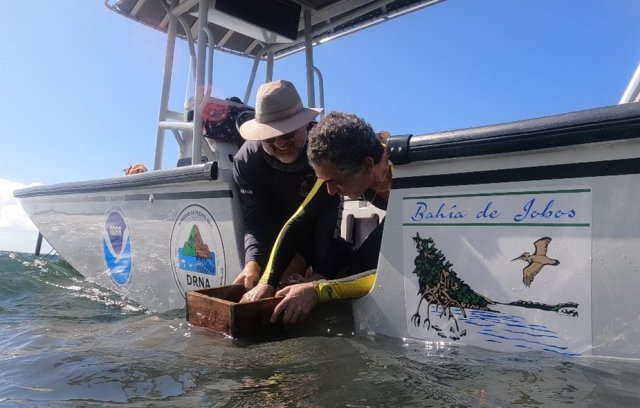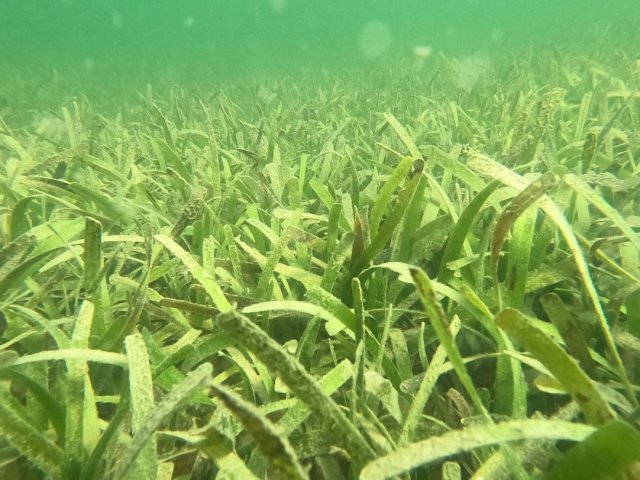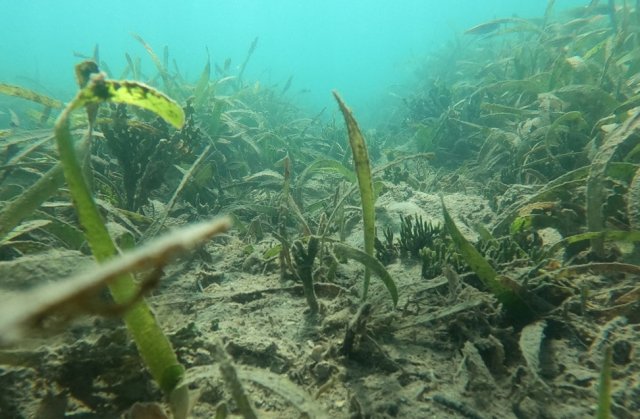In the Field with EPA: Seagrass Sampling to Expand a Nutrient Pollution Indicator

Published October 11, 2022
Native seagrasses are a foundation of healthy marine ecosystems and provide important ecosystem services. Threats to water quality, like excess nutrients, create unfavorable conditions for seagrass. To address this problem, EPA is working with partners in Puerto Rico on a new project to evaluate the potential applicability of a nutrient pollution indicator (NPI) for tropical seagrasses.
One focus of the project is to evaluate the ability to transfer an NPI developed for temperate systems to tropical systems. This NPI is the amount of nitrogen in the seagrass leaf compared to the leaf mass and is correlated with the nutrient concentration in the seawater of temperate seagrass systems. Since a tropical NPI may provide an early indicator of excess nitrogen availability, the first step is to collect seagrass samples for morphometrics (biomass, number of leaves, and leaf length, width, and thickness measurements) and tissue chemical analysis to determine if the NPI reflects nutrient concentrations in seagrass. Similarly, sediment and water samples were collected for nutrient analysis to determine if the NPI also reflects the nutrient conditions in the surrounding environment.
One of the sampled seagrasses is Halophila stipulacea, an invasive seagrass that is spreading through the Caribbean and colonizing embayments in Puerto Rico. H. stipulacea outcompetes native Caribbean seagrass species, negatively impacting fish diversity, and reducing feeding grounds for green sea turtles, an Endangered Species Act-listed species. Recent research suggests that successful colonization by H. stipulacea is related to high concentrations of nutrients in the water. Another focus of this project is evaluating the correlation between dense stands of invasive H. stipulacea and nutrient concentrations to better understand the relationship between nutrients and invasive seagrass colonization.

In June of 2022, EPA scientists worked with colleagues from the Departmento de Recursos Naturales y Ambientales (DRNA) at the Bahía de Jobos National Estuarine Research Reserve (NERR) in Puerto Rico to collect seagrass, water, and sediment samples. The research team collected samples of three native seagrasses (Thalassia testudinum, Syringodium filiforme and Halodule wrightii) and one invasive seagrass species (H. stipulacea). Over the course of two weeks, the team sampled 10 seagrass locations in three different bays with different nutrient conditions based on various levels of human influences like agriculture and high-density development. The samples were processed and stabilized in Puerto Rico and shipped to Oregon for laboratory analysis.
Researchers in EPA’s Oregon labs are working to analyze the water, sediment, and seagrass tissue samples. By measuring nutrient concentrations and stable isotope ratios in water and sediment samples, researchers can evaluate sources of nutrients. Both are important to track since they are tracers of nutrient pollution. Researchers will also measure a wide variety of seagrass morphology and tissue chemistry required to calculate the NPI. Using these data, EPA scientists can determine if the NPI will be a valuable tool to evaluate potential nutrient impairments in these tropical waters.

The project will help EPA by providing tools to assess nutrient pollution with respect to seagrasses through the NPI and by identifying nutrient conditions that may favor future colonization by H. stipulacea. Furthermore, understanding the role of nutrients in the development of dense mats of H. stipulacea may be of interest to other areas of the U.S., such as Florida and Texas, where this species is likely to spread. Results of this study could allow these states to identify locations with ideal conditions for H. stipulacea invasion and take precautions to protect their extensive native seagrass-dominated systems.
